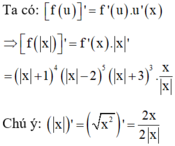Cho hàm số: y = f x = 3 - x 2 + 5 x 2 - 4 x ≠ ± 2 - 1 6 x = 2
- Xét tính liên tục của hàm số f(x) tại x= 2?
Hãy nhập câu hỏi của bạn vào đây, nếu là tài khoản VIP, bạn sẽ được ưu tiên trả lời.

Chọn A
f ' ( x ) đổi dấu khi x chạy qua -1 và 3 nên hàm số có 2 điểm cực trị.

Câu 1:
a)
| \(y=f\left(x\right)=2x^2\) | -5 | -3 | 0 | 3 | 5 |
| f(x) | 50 | 18 | 0 | 18 | 50 |
b) Ta có: f(x)=8
\(\Leftrightarrow2x^2=8\)
\(\Leftrightarrow x^2=4\)
hay \(x\in\left\{2;-2\right\}\)
Vậy: Để f(x)=8 thì \(x\in\left\{2;-2\right\}\)
Ta có: \(f\left(x\right)=6-4\sqrt{2}\)
\(\Leftrightarrow2x^2=6-4\sqrt{2}\)
\(\Leftrightarrow x^2=3-2\sqrt{2}\)
\(\Leftrightarrow x=\sqrt{3-2\sqrt{2}}\)
hay \(x=\sqrt{2}-1\)
Vậy: Để \(f\left(x\right)=6-4\sqrt{2}\) thì \(x=\sqrt{2}-1\)

\(a,f\left(1\right)=3\cdot1^2+1+1=5\\ f\left(-\dfrac{1}{3}\right)=3\cdot\left(-\dfrac{1}{3}\right)^2-\dfrac{1}{3}+1=\dfrac{1}{3}-\dfrac{1}{3}+1=1\\ f\left(\dfrac{2}{3}\right)=3\cdot\left(\dfrac{2}{3}\right)^2-\dfrac{2}{3}+1=\dfrac{4}{3}-\dfrac{2}{3}+1=\dfrac{5}{3}\\ f\left(-2\right)=3\cdot\left(-2\right)^2-2+1=11\\ f\left(-\dfrac{4}{3}\right)=3\cdot\left(-\dfrac{4}{3}\right)^2-\dfrac{4}{3}+1=\dfrac{16}{3}-\dfrac{4}{3}+1=5\)
\(b,f\left(\dfrac{2}{3}\right)=\left|2\cdot\dfrac{2}{3}-9\right|-3=\dfrac{23}{3}-3=\dfrac{14}{3}\\ f\left(-\dfrac{5}{4}\right)=\left|2\cdot\left(-\dfrac{5}{4}\right)-9\right|-3=\dfrac{23}{2}-3=\dfrac{17}{2}\\ f\left(-5\right)=\left|2\left(-5\right)-9\right|-3=19-3=16\\ f\left(4\right)=\left|2\cdot4-9\right|-3=1-3=-2\\ f\left(-\dfrac{3}{8}\right)=\left|2\cdot\left(-\dfrac{3}{8}\right)-9\right|-3=\dfrac{39}{4}-3=\dfrac{27}{4}\)
\(c,x=0\Rightarrow y=2\cdot0^2-7=-7\\ x=-3\Rightarrow y=2\cdot\left(-3\right)^2-7=11\\ x=-\dfrac{1}{2}\Rightarrow y=2\cdot\left(-\dfrac{1}{2}\right)^2-7=\dfrac{-13}{2}\\ x=\dfrac{2}{3}\Rightarrow y=2\cdot\left(\dfrac{2}{3}\right)^2-7=-\dfrac{55}{9}\)


Do đó hàm số f(|x|) có 3 điểm cực trị tại x= 2; x= -2 và x= 0
Chọn B.

1) \(f\left(x\right)=2x-5\)
\(f'\left(x\right)=2\)
\(\Rightarrow f'\left(4\right)=2\)
2) \(y=x^2-3\sqrt[]{x}+\dfrac{1}{x}\)
\(\Rightarrow y'=2x-\dfrac{3}{2\sqrt[]{x}}-\dfrac{1}{x^2}\)
3) \(f\left(x\right)=\dfrac{x+9}{x+3}+4\sqrt[]{x}\)
\(\Rightarrow f'\left(x\right)=\dfrac{1.\left(x+3\right)-1.\left(x+9\right)}{\left(x-3\right)^2}+\dfrac{4}{2\sqrt[]{x}}\)
\(\Rightarrow f'\left(x\right)=\dfrac{x+3-x-9}{\left(x-3\right)^2}+\dfrac{2}{\sqrt[]{x}}\)
\(\Rightarrow f'\left(x\right)=\dfrac{12}{\left(x-3\right)^2}+\dfrac{2}{\sqrt[]{x}}\)
\(\Rightarrow f'\left(x\right)=2\left[\dfrac{6}{\left(x-3\right)^2}+\dfrac{1}{\sqrt[]{x}}\right]\)
\(\Rightarrow f'\left(1\right)=2\left[\dfrac{6}{\left(1-3\right)^2}+\dfrac{1}{\sqrt[]{1}}\right]=2\left(\dfrac{3}{2}+1\right)=2.\dfrac{5}{2}=5\)
+) Ta có :
- Vậy hàm số đã cho liên tục tại x = 2.